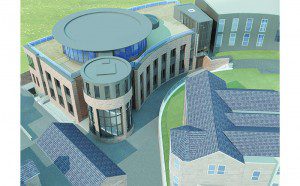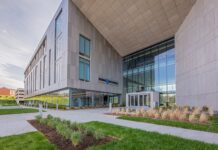
CONSTRUCTION has started on the new Higgs Centre for Innovation on the site of Edinburgh’s Royal Observatory.
Named after Nobel Prize winner Professor Peter Higgs of the University of Edinburgh, who predicted the existence of the Higgs boson, the facility will provide support for start-up businesses, especially focusing on big data and space technologies.
The centre is being funded through a £10.7 million investment from the UK Government. The Science and Technology Facilities Council (STFC) will invest £2 million over five years to operate it.
The facility will link “cutting edge scientific and engineering expertise” at STFC’s UK Astronomy Technology Centre with industry.
The building will be run by the STFC in partnership with the University of Edinburgh.
GRAHAM Construction is bulding the centre. Craig Giblett, contract manager for GRAHAM said, “The project will run for approximately 14 months through to the end of March 2017. It’s a basement construction of a retaining structure in the rock, followed by suspended ground floor slab, concrete frame and then a precast envelope with a mixture of stone, curtain walling and a mixture of different zinc with flat roofs on it.
“There’s basically a four metre deep hole, 50 metres by 20 metres wide, that we’ve got to form the basement structure in.
“Obviously it’s full of water at the moment so we’ve got the challenges of discharge of water, we’ve got the challenges of forming the basement and we’ve got the challenges of working on a very tight, constrained site. It is quite a detailed fit-out in terms of clean rooms and M&E and a high level of finish.
“Logistics are a big thing here, in terms of accessing the site, and also the building itself is relatively complex so it will be important to have the right supply chain involved to work with us to deliver it.”
Gillian Wright, director of the UK Astronomy Technology Centre added, “The project is to build a new building specifically designed to house business incubation companies and provide laboratory services for the growing space sector around Scotland, primarily, but not just the space sector, and to bring that together with our academic and engineering expertise in a way to foster innovation, new ideas and help companies to grow.”
Gillian said the centre will be occupied by firms that are “spinout companies from technologies that have been developed in physics and astronomy, companies that are trying to grow big data-type applications, we call it data-intensive science where it’s all about how you make use of the data, how you provide the tools, so there are a lot of things we could be doing with satellite data.
“Obviously I’m not a building expert, but a key thing for me was to have a building that would fit with and complement the historic site and that actually has fed into the design of the building, where it has a tower and the café on the top is a turret.”
Final designs for the building were also unveiled by jmarchitects.
Director, Ron McFarlane, said, “We are delighted to have been given the opportunity to be involved with this prestigious project, more so given its historic location and it being built in the name of the eminent Edinburgh scientist Professor Higgs.”







